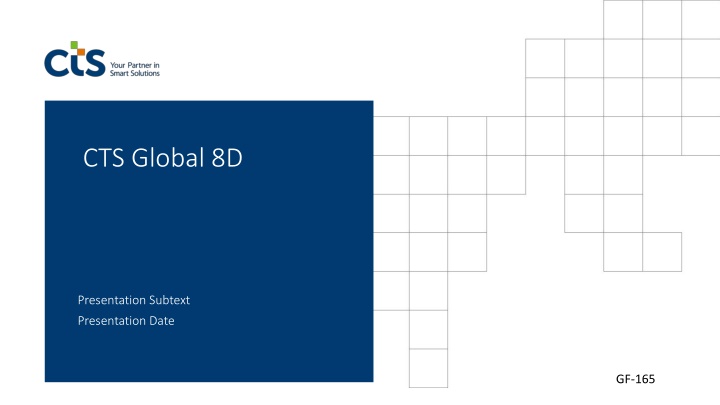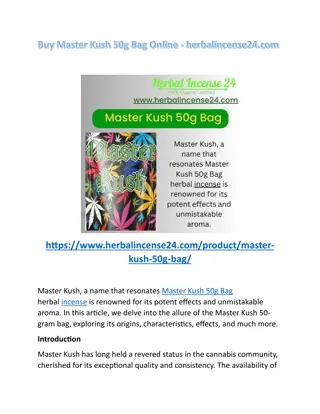
Implementing 8D Problem-Solving Process for CTS Global Team
"Discover how a cross-functional team tackles issues at CTS Global using the 8D problem-solving methodology. Dive into problem descriptions, guiding questions, and containment actions in this detailed presentation."
Download Presentation

Please find below an Image/Link to download the presentation.
The content on the website is provided AS IS for your information and personal use only. It may not be sold, licensed, or shared on other websites without obtaining consent from the author. If you encounter any issues during the download, it is possible that the publisher has removed the file from their server.
You are allowed to download the files provided on this website for personal or commercial use, subject to the condition that they are used lawfully. All files are the property of their respective owners.
The content on the website is provided AS IS for your information and personal use only. It may not be sold, licensed, or shared on other websites without obtaining consent from the author.
E N D
Presentation Transcript
CTS Global 8D Presentation Subtext Presentation Date GF-165
D1 Form a Team Roles Name Phone # E-mail address Position 8D Team Leader 8D Team Member 1 8D Team Member 2 8D Team Member 3 8D Team Member 4 8D Team Member 5 8D Team Member 6 8D Team Member 7 8D Team Member 8 Members should include all appropriate groups Cross Functional Team
D2 Describe the Problem Contrast of Actual and Desired Conditions Picture of CTS Requirement: Picture of Actual Condition: CTS Requirement is: Description of Actual Condition: Description of Desired Condition:
D2 Describe the Problem Guiding Questions 5W + 1H Where? Where? Who? Who? Type of process where defect occurred (stamping, molding, assembly, etc.) Identify CTS location(s) this product ship to? Have all CTS sites been notified? Why? Why? Who identified the problem (supplier, CTS, CTS customer? Has containment checklist been initiated? What? What? Is supplier quality alert in place for this issue? (including sub suppliers) What is the part description? How? How? List CTS part number(s) affected? How big is the issue? What serial number(s)? How severe is the issue? What cavity number(s)? What - What lot numbers? Is this a repeat issue? When? When? Was this part launched in the past 180 days? Was this part involved with an engineering change in the past 180 days?Any process deviations identified (machine mods, maintenance, line interruptions etc.), during the suspect production run. When was last known good part made? (left book end) When was the problem identified? Note: Answer above list of questions to help understand the problem.
D3 Implement Containment Actions Scope of Product Total qty pcs affected: CTS NCM number Affected Part Numbers Stop Date (Clean Point): Bookend Dates Start Date (Dirty Point): Delivery note: Traceability Information (Suspect serial numbers, lots, containers, etc.) (Inventory locations) Supplier (Including Sub-supplier) CTS Plant(s) including component warehouse CTS Customer(s) including Customer warehouse Quantity suspected (Including parts in transit) Quantities Affected Quantity contained Quantity Inspected Quantity of Rejects found Inspection Method Used MSA (Gage R&R, Kappa Score or Validation method)
D3 Implement Containment Actions # Action Person Responsible Date Completed 1 2 3 4 5 6 7 8 Note: Supplier must ensure that the implemented containment actions does not cause other problems.
D3 Implement Containment Actions Picture(s) of Certification Marking Method to Indicate Clean Point to your Customer (if applicable) Pallet marking Part marking Box marking Insert part part marking Insert pallet pallet marking Insert box box marking photo here photo here photo here
D4 Root Cause Analysis Must include the Fishbone and Five Why for Occurrence and Detection in the following slides . (Systemic 5why comes later)
D4 Root Cause Analysis - Fishbone Man Method Measurement Effect Machine Material Note: Circle the confirmed causes in red.
D4 Root Cause Analysis Cause & Effect Worksheet Man Accept Reject Explanation Method Accept Reject Explanation Measurement Accept Reject Explanation Machine Accept Reject Explanation Material Accept Reject Explanation
D4 Root Cause Analysis 5 Why for Occurrence & Detection Non-Conformity 5 Why Analysis Root cause Problem Definition Use this section to determine why the defect occurred Why ? Why ? Why ? Why ? Why ? OCCURENCE Problem Definition Use this section to determine why the defect was not detected Why ? Why ? Why ? Why ? Why ? DETECTION Note: Add why s or additional slides as needed Reference CTS Global 3x5 Why, GF-xyz
D4 Root Cause Analysis Reproduction of Failure Please add details to next slide which explains your efforts and results to reproduce the failure mode. Evidence that you have found the true root cause is that you can turn on and off a problem. Example 1: You change parameter X and you can make dimension Y move outside the tolerance. When you change back parameter X the dimension Y moves back within specification again. Example 2: You change a force on a pressing operation and the strength moves outside specification. When the force is changed back, the strength the moves back inside specification again.
D4 Root Cause Analysis Verification of Root Cause Efforts and Data that Supports/Proves the Root Cause (Example: turn on/off) Root Cause (From previous pages) Occurrence Cause Detection Cause
D5 Choose & Implement Corrective Actions Completion Date of Corrective Action Corrective Action(s) Occurrence Cause Detection Cause
D6 Effectiveness of Corrective Actions Confirm the problem is eliminated! Affected Part Number(s) Corrective action implementation date*: Quantities Affected Quantity inspected Quantity of Rejects found Inspection Method Used MSA (Gage R&R, Kappa Score or Validation method)
D7 Prevent Reoccurrence Systemic 5 Why 5 Why Analysis Non-Conformity Root cause Problem Definition Use this section to determine the systemic root cause Why ? Why ? Why ? Why ? Why ? SYSTEMIC Systemic Root Cause Analysis Please answer the following- Why did the planning of the business process not predict (e.g. PFMEA/ risk analysis) the problem? Why did the business process (process and product development/ validation) not prevent the problem? Why did the business process (e.g. process control plan/ sensors/ poka yoke) not protect the customer (or next operation)? Reference CTS Global 3x5 Why, GF-xyz
D7 Implement Systemic Corrective Actions Completion Date of Corrective Action Corrective Action(s) Systemic Cause
D7 Prevent Reoccurrence Read Across CTS RA# CTS RA# List Corrective actions List Corrective actions List Similar Areas for Lessons Learned/ Read Across List Similar Areas for Lessons Learned/ Read Across (Processes, Products, Machines etc..) (Processes, Products, Machines etc..) Date (or N/A) RA#xyz Action 1 Process / Area / Sister Plant Owner Date (or N/A) Date (or N/A) Action 2 Date (or N/A) Date (or N/A) Action 3 Date (or N/A) Action 4 Reference CTS Lesson Learned/Read Across, GP-055
D7 Prevent Reoccurrence PFMEA Update Screen shot of PFMEA before Screen shot of Control Plan before Screen shot of PFMEA after Screen shot of Control Plan after
D8 Congratulate Team How was the team s success/lessons shared?: Has the 8D been stored properly in the CAR database? Methods you should consider to use to congratulate the team may include the following: Closing team meeting Management reviews Individual letters / Newsletters Special awards Congratulating members during work area or facility meetings


